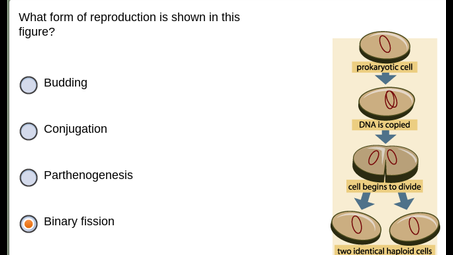Add your answer:
What form of asexual reproduction is shown here?
The image shows binary fission, a form of asexual reproduction where a single organism divides into two offspring of equal size. This process is commonly observed in single-celled organisms like bacteria and protists.
Is Binary fission the most common form of reproduction?
Binary fission is a common form of reproduction among prokaryotic organisms, such as bacteria. However, it is not the most common form of reproduction across all organisms. Other forms of reproduction, such as sexual reproduction and asexual reproduction through budding or fragmentation, are also prevalent in different species.
Budding is a form of what?
Budding is a form of asexual reproduction in which a new organism develops as an outgrowth from the parent. It is commonly observed in organisms such as yeast, hydra, and some plants.
Do fish produce sperm as a form of reproduction?
Yes, fish produce sperm as a form of reproduction. Sperm is the male reproductive cell that fertilizes the female egg to create offspring.
In fungi what is produced by asexual reproduction?
In fungi, asexual reproduction produces spores. These spores can be dispersed and germinate to form new fungal organisms.
What form of asexual reproduction is shown here for a salamander?
parthenogenesis
What form of asexual reproduction is shown here lizard?
It can be parthanogenesis.Female gamete is turned into new organism without fertilization.
Which reproduction is binary fission budding and vegetative reproduction related to?
These are all a form of asexual reproduction.These are all a form of asexual reproduction.
What is vegetative reproductions?
this form of reproduction does not involve the formation of seeds.
What form of asexual reproduction is canola?
Canola is a plant ,not a form of asexual reproduction .
What kinds of clouds form along the front figure 1?
Cumulus and cumulonimbus clouds are likely to form along the front shown in Figure 1. These clouds are associated with unstable atmospheric conditions, often bringing precipitation and thunderstorms.
What form of asexual reproduction is shown here?
The image shows binary fission, a form of asexual reproduction where a single organism divides into two offspring of equal size. This process is commonly observed in single-celled organisms like bacteria and protists.
what- yuki is provided with the figure shown. it is given that ...?
A+
Is it correct to say shown in drawing or shown on drawing?
It would be more correct to use "in" than "on". But rather than using "drawing" it might be better to use the word "illustration" or "figure" unless you were referring to an actual drawing as a piece of artwork.
Which form of reproduction leds to the greatest genetic diversity?
Sexual reproduction.
Is mitosis a form of sexual reproduction?
No it is not. Meiosis is involved in sexual reproduction
How many different labeled rays are shown?
There are two different labeled rays shown in the figure.

